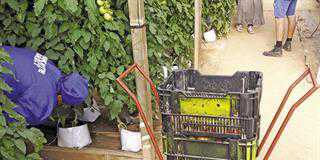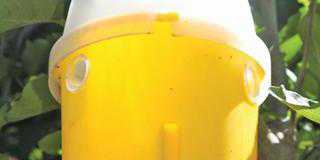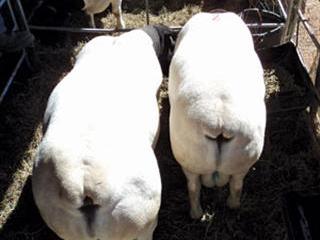
Scientists Das Marais and Willem Olivier set up a trial to find out whether lambs kept on veld in the early growth period compensate in muscle and fat development at a later stage, when they are fed on a higher plane of nutrition. Compensatory growth is the ability of animals to show high growth when free access to good quality feed is provided, after being subjected to a period of undernutrition.
Undernourished animals can show better gains with improved feed conditions than animals on a continuous feed regime. Compensatory growth, induced by better feed utilisation, results in changes in body composition, with less fat but more protein being laid down. Put differently, the lean content of the carcass increases while the fat content diminishes.
A key driver behind this research was to assist commercial Dorper farmers with ram selection. At sales, farmers choose between intensively fed rams or veld rams reared under natural grazing conditions from birth. The situation is complicated by the custom of feeding veld rams high quality rations for a month or two before a sale.
When these rams are put on sale alongside rams that have been on a high nutritional plane throughout their lives, it becomes difficult to decide to choose a sire on phenotype (visual appearance) alone. Even if growth performance data is available, the veld rams could still be at a disadvantage in terms of looks, leading the buyer to opt for the store-fed animal.
Nutritional advantage
While some farmers believe veld rams can catch up in terms of eye muscle area to their intensively reared counterparts after two to three months on a higher nutritional level, it was not clear before this study whether veld-reared lambs could catch up with lambs on a higher feed plane during early growth.
The trial showed that compensatory growth did indeed occur in lambs switched from a low to a higher feeding level. Further, this compensatory growth resulted in more muscle tissue being developed than fat due to an increase in protein deposits. However, lambs reared on the higher feeding level early in life retained their advantage over those reared on a lower feeding level.
Dorper Trial
For the trial, 48 weaned Dorper ewe lambs were divided into four groups. Groups FF and FN received a diet with high protein and energy levels for eight months under kraal conditions. Groups NF and NN were kept under natural grazing conditions (false upper Karoo ecosystem) for the same period.
After eight months, treatments for groups FN and NF were changed while treatments of groups FF and NN remained the same. Group FN was moved to natural grazing and group NF to a feedlot. The feed consisted of 46% lucerne hay, 35% maize meal, 10% soya cake meal, 8% molasses meal and 1% feed lime.
Some of the findings:
- The body weights of the feedlot groups increased by more than 35kg during the first eight months while the natural grazing groups gained 18kg in body weight. This difference was noted from six months. During phase two of the experiment, the body weight of group FN decreased by 2,2kg while group NF increased 12kg. At the same time, body weights of the FF and NN groups increased by 6,1kg and 7,2kg respectively. These responses show compensatory gain in response to an improved feed regimen after a period of restricted intake.
- The eye muscle area of the feedlot groups increased by more than 17cm2 during the first eight months. Despite the increase in body weight, the eye muscle area of group FF did not change during phase two, while there was a slight increase in the eye muscle area of group FN, despite the decrease in body weight.
- The fat depth of the feedlot groups increased by more than 4mm from 5 months to 12 months.
- The fat depth of animals from group NF increased by only 0,25mm/cm2 increase in muscle area compared to the increase of 3mm/cm2 increase for group FF. This suggests that more protein and less fat was deposited in group NF than group FF during phase two – the result of better feed utilisation.
- Irrespective of feeding level, the differences in eye muscle area between groups decreased towards the end of the experimental period.
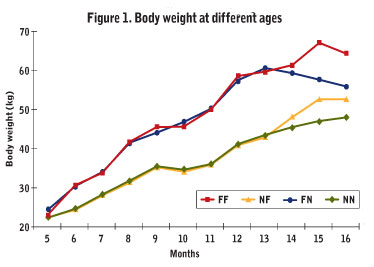
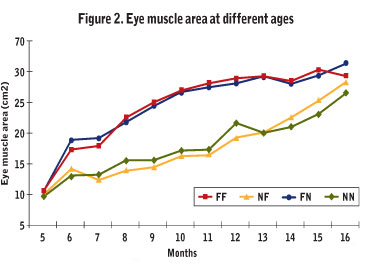
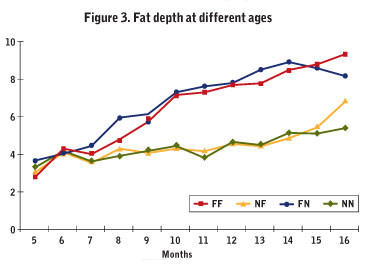
Graphs on opposite page Courtesy of Grootfontein Agricultural Development Institute
Source: PG Marais, WJ Olivier & CG Stannard, 2011: The Effect of Early Growth Environment of Dorper Lambs on M. Longissimus Dorsi Area at 16 months.
Contact Willem Olivier at [email protected]











